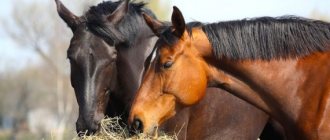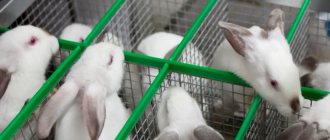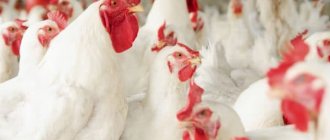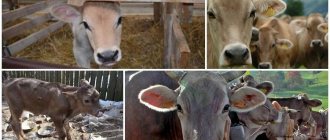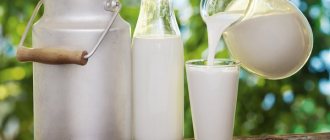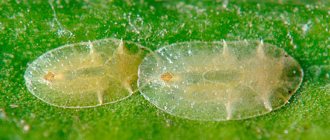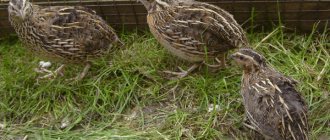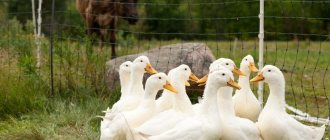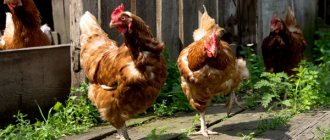What is included in rabbit feed?
The main components of the feed are grains: wheat, corn, barley, oats, etc. They make up from 30 to 45% of the total mass of the feed. Next come components containing a lot of protein: cake, soybean and/or sunflower, as well as hydrolyzed yeast and soybean sprat.
Interesting materials:
How to clean masking tape from metal? How to wash a matte pen case? How to clean a cat from a mattress? How to wash linden off shoes? How to wash off propolis? How to clean a plastic wine barrel? How to clean a plastic barrel from machine oil? How to wash dishes from old grease? How to wash a handle from the leather of a chair? How to wash a pen from eco leather?
How much of this food should a rabbit eat in one day?
When the question arises, what should be the daily amount of compound feed eaten by a rabbit, you must proceed from the breed and age of the pet. The daily value can be calculated in several ways.
- You can calculate the so-called feed unit. For example, 100 g of feed unit may contain 100 g of oats or other crops.
- Calculate the daily intake of proteins. For animals that have not yet reproduced, the daily norm should be about 150-160 feed units. For an adult male, these figures per day should be 180 feed units, but a female who has given birth and is nursing should consume about 300-700 feed units. The daily rate may even depend on the color of the rabbit. A light-colored rabbit eats much less than a dark-colored rabbit. During the mating period, they should be given much more food per day than during the normal period. When raising an animal for further slaughter, it is necessary to fatten it in advance, thereby increasing the amount of food not only per day, but also per month. In this case, it is possible to determine the norms that are necessary for the rabbit’s body.
- Adults weighing up to 5 kg need to eat about 5-6 kg of food per month.
- If the rabbit is no more than 4-5 months old, he will need approximately 3-4 kg per month.
Based on approximate annual and monthly calculations, you can create the nutrition that a rabbit should receive per day.
- for a nursing rabbit - approximately 100 g;
- for sufficiently mature males - 60-70 g;
- for still young rabbits - 40-50 g;
- when raising decorative rabbits - no more than 1 tbsp. l. per day.
It is worth paying attention to the fact that for still small rabbits, the norms for such consumption will be completely different. If a small rabbit is already 35-40 days old, then it can be given about 100-130 feed units per day. In 1 day, a small rabbit aged 60 days eats approximately 150 food units. If the question arises of how much a 4-month-old rabbit needs, such norms should be about 200 feed units. For young animals aged 120-130 days, these indicators should be at the level of 225 feed units.
What is feed made from?
Main components included:
- grain of wheat, barley, oats, corn;
- sunflower cake;
- legume grains: beans, peas, soybeans, lupine;
- oilseed grains: sunflower, rapeseed, rapeseed;
- roughage as a source of fiber;
- bran;
- bone flour;
- mineral, vitamin supplements, biostimulants.
In addition, to improve digestion, high-quality industrially produced feed includes:
You may be interested in: Industrial cages for rabbits at home: drawings How to make drinking bowls for rabbits with your own hands Cages for rabbits with your own hands: photos, original ideas
- acetic, ascorbic, benzoic and sorbic acids;
- ammonium hydroxide as a mold inhibitor;
- beet pulp – sugar production waste;
- source of calcium – limestone or calcium carbonate;
- source of protein – rapeseed flour, made from rapeseed after pressing the oil;
- B4 or choline chloride;
- preservative – citric acid. The use of citric acid helps to enhance growth and increase immunity in animals;
- flavoring additive – corn gluten;
- magnesium oxide;
- binding component and source of magnesium – black or cane molasses;
- source of phosphorus – monosodium phosphate;
- papaya to improve digestion;
- soybean hulls as a source of fiber;
- safflower flour as a source of protein;
- rosemary extract – a perfect natural antioxidant;
- safflower oil to improve taste;
- soybean meal is a source of protein;
- yucca to normalize the animal's gastrointestinal tract.
Concentrate in the daily diet: pros and cons
Combined feed (mash) is an easy source of essential nutrients. Some owners prefer to do without it due to obesity and problems with teeth and gastrointestinal tract in their pets.
Compound feed makes it easier for the owner to feed their pets, but threatens the latter with health problems
Eating without feed requires more effort and care. The pet may suffer from malnutrition and lack of certain elements.
The ready-made mixture is convenient, but it is better if it makes up a small proportion of the diet: being a concentrated form, it contains many ingredients in a small volume. This is exactly the opposite of a rabbit's natural diet - lots of food with little nutritional content.
Increasing the weight of rabbits using additional methods
Rabbit breeders with extensive experience use auxiliary methods to activate weight gain in their pets.
The basis of the winter diet of rabbits is roughage and concentrated feed.
Additional productive methods that ensure weight gain in animals include:
- Rational seating of rabbits. In a herd, animals are divided into stronger and weaker ones. All pets need to receive food in equal portions. To do this, you need to group rabbits taking into account their temperament.
- Limited space. The mobility of rabbits is limited by the small area. With minimal movement, rabbits can quickly gain weight.
- Monitoring the filling of the feeder. After each feeding (4-5 times a day), the food container is cleaned. Empty food boxes are filled again.
Breeders successfully take advantage of another feature of rodents - activity at night. Shielding the cage from daylight increases the rabbits' need for food. But regular exposure of animals in semi-darkness is contraindicated.
What not to give
Harmful to fluffies:
- beans cause constipation;
- beet;
- cabbage;
- coffee, tea leaves;
- corn;
- green bean;
- onion;
- nuts;
- peas;
- potato;
- rhubarb;
- spinach.
Do not feed under any circumstances
- chocolate (poison for rabbits);
- cookies;
- crackers;
- breakfast cereals;
- yogurt;
- pasta;
- fresh, undried bread.
Homemade feed
Mixed feed prepared by yourself is cheaper than purchased and allows you to change the recipe at your discretion. To make compound feed for rabbits with your own hands, you need an extruder. The device is not cheap, but you can always find a used one.
Manufacturing process
Some breeders make do with a mixer, a meat grinder and a feed granulator. Instead of a granulator, you can use a drill and an attachment for mixing cement. Pelleted food is higher in calories, which means rabbits gain weight faster.
The manufacturing process begins with grinding grain and other components, which are then mixed and placed in a granulator. The size of the granules depends on the size of the nozzle used. The extruder mixes, shapes and heat treats all ingredients. The granulator works like a press; the feed it produces is stored less than after heat treatment.
Animals receive higher quality food, which, moreover, is required in half. Another plus is that the high manufacturing temperature will free products from toxins and harmful microorganisms.
Complete mechanization of the feed creation process is impossible without a feed granulator or extruder, grain crusher, oil press, dryer or hay chopper and brush cutter. A walk-behind mower is relatively inexpensive and helps produce large quantities of hay with less physical effort. A dryer is needed for high-quality drying of hay, without mold or mustiness. Using a crusher, grain is processed into flour. A screw oil press crushes oily crops.
Complete mechanization of the feed creation process is impossible without a feed granulator or extruder, a grain crusher, an oil press, a hay dryer and chopper, and a brush cutter. A walk-behind mower is relatively inexpensive, but it helps produce a large amount of hay. A dryer helps avoid mishaps when drying herbs. The purpose of the grinder follows from the name: with its help, the grass is turned into a mixture. With the help of a crusher, grain is processed into flour. A screw oil press crushes oily crops.
Ingredients for feed
If you don’t have all the necessary equipment at hand, don’t despair, because in compound feed the main thing is not the shape of the granules, but the constituent components. With a large number of animals, it is better to mechanize the entire process of producing feed, but for small farms some of it can be replaced by manual labor.
The main advantage of making it yourself is the cheap price of the food, the ability to control the quality of the ingredients, change their proportions and recipe.
Excess feed can always be sold. This is a good additional source of income.
The feed includes:
- cereals;
- green feed;
- vitamin and animal impurities.
Cereals are an integral part of an animal’s complete diet. They are responsible for gaining and maintaining weight and providing animals with fiber and protein. Oats, barley, corn, wheat, sunflower seeds, soybeans, and legumes are suitable for rabbits. Plant stems, tops from the garden, straw, fresh grass, root crops and vegetables are used as green feed.
Green feed is necessary for the growth and development of animals; their use reduces the cost of the finished product. Vitamin and animal impurities include milk powder, soybean meal and sunflower cake, yeast and vitamin mixtures, fish and bone meal, chalk, premixes. These supplements are essential for animal immunity.
The composition of home-prepared food should depend not only on the available ingredients, but also on the age, sex and health status of the animals.
It is impossible to raise large rabbits without feed
According to rabbit breeders, the advantages of home-made feed are as follows:
- animals gain weight faster
- get sick less
- more balanced nutrition,
- optimization of feed supply.
Nutritional supplements for artificial weight gain
To improve appetite, breeders add vitamins to pet food. Beneficial substances of groups A and E are used together with fats, vitamin D is added to thick and porridge-like food. The drink is diluted with vitamin C.
After consultation with a veterinarian, animals are prescribed vitamin-mineral, as well as protein-vitamin-mineral supplements (PVMD).
They strengthen the animals’ bodies with useful microelements: manganese, calcium, phosphorus. Protein-containing options provide protein to the animal's muscles.
Vitamin and protein supplements have no contraindications. The correct dosage is calculated taking into account the body weight and age of the pet. The use of additives above the norm worsens the taste characteristics of rabbit meat.
Daily norm
For young animals there is a more detailed gradation depending on how many days of life have passed since birth. The dosage for a female rabbit is mainly tied to her task of increasing offspring: litter and lactation. Different breeds require an individual approach.
The use of mixed feed does not affect the amount of water required. It should always be in sufficient quantities and be fresh.
Fattening rabbits. How to properly fatten rabbits
Fattening rabbits is necessary to increase the weight of animals, their fatness, accumulation of internal or subcutaneous fat, to improve the taste of meat, as well as to improve the quality of hair.
Rabbits are fattened six weeks before slaughter. It is not recommended to keep more than six animals for fattening in one cage. If there are not enough cells, all rooms can be temporarily adapted for these purposes.
Groups of rabbits are formed from animals that are equally developed. Otherwise, the stronger ones will drive the weaker ones away from the food and they will not achieve the required fatness.
When setting up for fattening, the time of seasonal and age-related molting should be taken into account. Therefore, animals are selected for fattening in which fattening will completely cease by the time of slaughter. Young rabbits are slaughtered at the age of 4.5 or 7.5 months.
The best time to slaughter rabbits is from November to February. At this time, the fur of animals becomes the most durable and thick, it acquires shine. This is caused primarily by physiological characteristics, and secondly by the fact that high-protein feeds predominate in the diet.
Conventionally, the fattening period is divided into three periods of two weeks each.
Period I - fifty percent of the diet should consist of concentrates.
Period II - peas, oats, corn, barley, potatoes are introduced into the diet, i.e. those feeds that contribute to maximum fat deposition. All this is steamed together and a semi-dry mash is prepared. Salt, bone meal and chopped nettle are added to it. You can also add duckweed, which is harvested in the fall, to the mash.
III period - parsley, dill, celery are added to the hay.
In order for rabbits to eat food better during the fattening period, they should be given lightly salted water, which significantly increases their appetite. When fattening in winter, salted ice is given.
During the last period of fattening, animals become inactive and they completely lose interest in food. This serves as a signal that it is time to remove the rabbits from fattening. A well-fed rabbit at slaughter has significant fat deposits in the groins, shoulder blades and kidney area, which are barely noticeable in the layer of fat.
How to fatten a rabbit for meat?
The second important factor that allows you to quickly fatten rabbits for meat is good living conditions. Here it is necessary to follow the growing technology, properly prepare and place the rabbitry, and organize the supply of food and water. It is also necessary to decide on the main method of raising rabbits and develop an optimal diet that will ensure full development of the animals.
Note. To keep rabbits, one- or two-tier wooden cages are prepared. The corners of the structure are reinforced with sheet iron. It is convenient to have a double floor in the cages, with the upper tier being a grate through which manure is poured into a tray. This greatly simplifies care and increases the hygiene of cultivation.
Diet for fattening for meat
Nutrition for rabbits includes foods balanced in protein and carbohydrate content. Also, to accelerate weight gain, industrial feed is used, which can be the basis of the diet or added in small proportions.
It is necessary to fatten rabbits at home in accordance with the following recommendations:
- Mandatory use of silage. This is a valuable source of vitamins and minerals, the deficiency of which is especially acute in late winter and spring. To make silage, you can use corn, cabbage leaves, carrot and pea tops. Sunflowers, quinoa, and freshly cut field herbs are also used.
- To quickly gain weight, it is important to provide animals with sources of protein. For this purpose, mixed feed, legumes and cereals are used. Hay is also prepared from legumes and cereal grasses, which is added to food in dried and ground form. It is advisable to combine several types of grains, for example, give the animals wheat, oats and barley alternately.
- Adding branch feed. This is a source of nutrients and vitamins necessary during the period of intensive growth of young animals. For this purpose, branches of willow, linden, acacia, aspen and willow are used.
- Be sure to include root vegetables and melons in your diet. They are an important source of energy and vitamins. Potatoes, pumpkin, and zucchini are suitable food for rabbits. They are pre-boiled and mixed with feed, meal or cake to increase nutritional value.
Vitamin and mineral supplements, which are sold in veterinary pharmacies, contribute to rapid weight gain. Their dosage is indicated in the instructions and must be strictly followed by the breeder. Chalk is added to food for rabbits during periods of intensive growth.
Growing technology
Breeding rabbits for meat at home requires purchasing or constructing cages yourself. The rabbitry should have lighting, a heating system for year-round rearing, and good ventilation. With a small population, adding feed and water and cleaning cages can be done manually, while on large farms these processes are automated using hopper feeders and a nipple drinking system.
The technology for raising rabbits is based on life cycles:
- Mature rabbits aged 4-6 months are allowed to mate;
- The female rabbit comes into heat every 8-9 days and lasts up to 5 days;
- after giving birth, the rabbit’s ability to conceive is restored within 1-2 days;
- an adult female is capable of giving up to 5 litters per year, young female rabbits give 1-2 litters;
- the strongest and healthiest rabbits are selected for fertilization at the rate of 1 male per 8 females;
- the litter per litter for female rabbits of different breeds is 6-18 young rabbits;
- Early maturing breeds are ready for slaughter at the age of 3-4 months.
In order to get a good meat yield and quick payback, it is necessary to maintain optimal housing conditions, promptly vaccinate animals, and organize veterinary examinations.
Growing methods
Raising rabbits for meat involves the use of two different methods: purebred and crossbreeding. In the first case, the strongest and healthiest representatives of the breed are selected for breeding in order to preserve all the best characteristics of the breed. The female and male for mating are selected from different family lines to avoid degeneration. Such mating produces weak, sickly offspring.
Reference. With the purebred rearing method, the optimal mating scheme is the selection of grandchildren and great-grandchildren in the same kin group, as well as nephews and nieces. Closer genes may produce undesirable manifestations in the form of abnormal breed traits and genetic abnormalities.
Interline crossing involves mating the best representatives of different lines or breeds of animals. This method is especially widely used in industrial cultivation.
Nutrition Basics
To raise rabbits, you need to know the basics of rabbit farming. It is important to carefully monitor compliance with the following rules:
- It is forbidden to feed food with signs of spoilage and mold. Such food can not only poison, but also kill your pet.
- The greens are given without dew; they should be dry to the touch.
- A varied diet changes from time to time and is supplemented with new products.
- There should always be fresh water in the drinking bowl, which is changed every 1-2 days. Absence will cause constipation and decreased lactation in lactating females.
- Rabbits are trained to a feeding schedule by giving food at specific times each day.
- Rabbits of different ages, genders, breeds and purposes have different diets.
Experienced rabbit breeders advise that the animal always have stable access to a food source. In the wild, they do not feed on a schedule. This must also be ensured in cellular conditions. You can read more about this in Mikhailov’s method.
The pet should eat not only plants, but also animal products (fish oil, bone meal). In addition, it is useful to provide silage, which includes the necessary microelements.
Types of feed
Several types of feed are used to feed rabbits, and they are alternated with each other, which allows them to achieve the most balanced and nutritious diet.
A monotonous menu has a bad effect on the condition of rabbits
Table 1. Types of food for rabbits
Attention! Features of feeding rabbits in winter and summer differ from each other. During the cold season, animals must receive an increased amount of nutrients, since they are deprived of succulent feed.
Feed for rabbits: pros and cons
Compound feeds for feeding rabbits contain all the substances necessary for animal health in the correct ratio, which promotes rapid growth and weight gain. They are convenient to transport and store, and the use of such products saves the time and labor of the farmer, which is required to prepare feed mixtures for livestock. There are many options for mixed feed in different price categories, so choosing the best one will be very easy.
Compound feed contains all the components necessary for animals, but requires caution when using
However, the use of mixed feed has a number of significant disadvantages that should be taken into account:
- dry feed mixtures do not exclude the use of succulent feed, otherwise the rabbits will not receive enough moisture and nutrients;
- the granules quickly become soaked in the oral cavity, which disrupts the natural process of self-sharpening of the incisors and can cause dysfunction of the dental system;
- when using mixed feed, fine dust is formed, which becomes clogged in the respiratory tract of rabbits;
- The products contain synthetic vitamins and minerals - they are not as beneficial for animal health as “live” nutrients, and some contain sugar, which is addictive in rabbits.
Juicy food goes well with granulated food and provides rabbits with a complete diet
Considering the features and disadvantages of using mixed feed, we can conclude that they can be used to feed rabbits, but you should not rely solely on the manufacturers of such products. In order for the diet to be balanced, concentrated feeds must be mixed with rough and juicy feed, and also vitamins and microelements that are not included in ready-made mixtures must be added to the animals’ diet.
When using compound feed, it is important to give rabbits a sufficient amount of water, since concentrates do not contain moisture.
Important! Decorative dwarf rabbits cannot be fed with compound feed intended for industrial species of animals. They contain a high concentration of fats and proteins, which will cause obesity and health problems in individuals.
Feed composition
As the name suggests (mixed feed is an abbreviation for the phrase “combined feed”) it contains several types of food and is prepared according to different recipes.
The basis of compound feeds is usually vegetable raw materials or grass meal
The raw materials for the manufacture of products can be:
- dried plant mass, herbal, pine flour;
- animal components – fish or meat and bone meal;
- high carbohydrate cereals;
- vitamin and mineral supplements;
- food production waste – cake, bran.
When choosing feed, the breed, age and body characteristics of the individual are taken into account.
The proportions of ingredients depend on the purpose for which the food is intended, since different breeds of animals at different periods of life require a certain amount of nutrients, vitamins and microelements. The most common types of feed include:
- PC 90, 90-1 are intended for rabbits that have recently been separated from the female;
- K 91-1 is used for feeding young individuals;
- K 92-1, 92-2 are given to adult animals;
- K 93-1 is intended for meat breeds of rabbits, as it provides good weight gain.
The daily norm of finished feed also depends on the age, breed and body characteristics of rabbits, and on average is 60 g daily, but can be increased to 160 g.
What you can feed and what you can’t
When deciding what to feed your rabbit if you run out of food at home, you should not give the following foods:
- sweets;
- sausages;
- meat and dairy products;
- legumes;
- nuts;
- potato;
- flour products;
- poisonous plants.
Expert opinion
Dobryshev Sergey Anatolievich
Professional rabbit breeder with 30 years of experience
Note! When compiling a menu from the list of permitted products, you need to take into account that it will vary depending on the time of year
What and how to feed in winter
During the winter season, rabbits are deficient in nutrients. Therefore, food should contain many vitamins and minerals. Hay and fermented green food are ideal. It is also necessary to give fish oil in the following dosage:
- for young animals - 0.5 g;
- for rabbits during lactation - 3 g;
- pregnant females - 2 g;
- for other individuals - 1 g.
Expert opinion
Dobryshev Sergey Anatolievich
Professional rabbit breeder with 30 years of experience
Important! How many times a day should decorative rabbits be fed with fish oil - 1. Sprouted grains contain a lot of vitamin E, so it is recommended to include them in the diet of adults and young animals
Brewer's yeast is also useful. Over 5 days, one individual should be given approximately 6 g of the product, then take a break for 72 hours
Sprouted grains contain a lot of vitamin E, so they are recommended to be included in the diet of adults and young animals. Brewer's yeast is also useful. Over 5 days, one individual should be given approximately 6 g of the product, then take a break for 72 hours.
For the winter, you can ferment turnips, grass, and cabbage in a barrel. Add carrots and salt to this (1% of the total mass). How many times to feed a decorative rabbit at home with this mixture is up to the owners to decide on their own.
The main thing to consider is that there should be 300 g per adult, 100 g per rabbit. In winter, the amount of concentrated feed should be 50% of the total volume, the rest is silage and succulent food (for example, boiled root vegetables).
What and how to feed in summer
In the summer, decorative rabbits should be fed mainly with green food. It can also be varied with fruits, berries and vegetables, waste from them (cake, etc.). It is good to use root vegetables.
To improve the functioning of the gastrointestinal tract, it is recommended to include the following plants in the menu:
- sagebrush;
- dill;
- yarrow;
- chicory.
To prevent dental problems, it is advisable to give dried garlic stalks. It is recommended to include plantain in the diet, because it has an antibacterial effect. If you give your rabbits nettle, it will enrich the body with a large amount of vitamins.
How many times a day to feed a decorative rabbit in an apartment, the owners decide for themselves
It is only important to take into account that the daily dosage for adults is 600 g. For pregnant females, the norm should be doubled
Give 150 g to young animals, increasing the dose as they grow older.
Disadvantages and advantages of such feeds
In addition to how much food a rabbit can eat during the day, it is worth paying attention to the advantages and disadvantages of compound feed. The main advantages include:
- providing the body with useful substances;
- the possibility of rapid growth and weight gain;
- the fact that this is an ideal option for nursing rabbits;
- simplicity in terms of transportation and storage;
- possibility of independent use at home.
In addition to the advantages, there are also certain disadvantages, which include:
- quite high price;
- the need for the correct selection of food for each animal;
- short shelf life;
- the need to constantly monitor the composition so that there is no excess of certain elements.
If you decide to raise rabbits on your farm, you must take a responsible approach to their nutrition so that the pets grow up healthy.
Slaughtering rabbits and removing skins
Author: Alex | Category: Rabbit breeding | 08-09-2011
The time of slaughter of rabbits is determined by the thickness of the fur, as well as its molting. They directly depend on the age of the rabbit and the time of year. In adult rabbits, shedding occurs twice a year, namely in spring and autumn. Male rabbits begin molting in early March and finish molting in early August. Autumn molting begins at the end of August and ends in November or October.
Female rabbits, before their first birth, wear skins with dull, browned, sparse and stunted hair. After the first spring birth, they begin to shed intensively, starting from the nape and front of the ridge. Therefore, it is better to slaughter adult rabbits in late autumn. The first molt in rabbits occurs at the age of a month or even earlier. For rabbits born in late winter or early autumn, the molt ends at three months of age, the second ends at five months, and the third ends at eight months. So the best skins will be slaughtered from late autumn to early spring.
12-18 hours before slaughter, rabbits should not be fed or given water. They kill a rabbit like this: they take it by the hind legs in one hand, and with the other, when the rabbit stretches out, they strike behind the ears, remove the eyes and cut the septum on the nose. After which the rabbit is suspended by its hind legs so that all the blood can drain. Once the rabbit has been completely bled dry, you can begin skinning.
The skin is removed from a rabbit suspended by its paws using a pipe. Incisions are made around the hock joints of the legs, then on the thighs towards the anus. After the skin has been removed from the hind legs, the vertebrae are removed from the tail and the skin is pulled towards the head, cutting the film with a knife if necessary. When the skin is removed from the body, cut off the paws at the wrists and remove the skin to the end.
The removed skin should be degreased with a knife, and it is also necessary to remove the remaining meat. The size of the skin is determined by multiplying the length by the width. On a skin with a head, the length is measured from between the eyes to the tail, respectively, if the skin is headless, you need to measure from the beginning of the edge.
Skins belonging to the third and fourth grades are not distributed by size. The skin itself must be hung on a pre-prepared straightener with the hair inward. Then the skins are placed to dry in a ventilated room, where the temperature is from 20 to 30 degrees.
You cannot dry the skins in the open sun or near a stove; the skin may dry out and deteriorate, and the skin will break. After the skin is completely dry, the inside is wiped with sawdust, and only then the skin is handed over to procurement organizations.
Sources: krol.org.ua, oleg-inform.ru, www.lynix.biz, d-givotnovodstvo.narod.ru, zoo-farm.ru
How to cook rabbit with vegetables
Stewed rabbit is not a dish that can be prepared in a hurry. You need to tinker with it a little, you will have to watch the process...
What breeds of ducks are there?
Meat type ducks are the most widespread. They are characterized by high fertility, early ripening, good vitality, tasty and nutritious meat and...
Pododermatitis in rabbits
Pododermatitis is a non-contagious disease of adult rabbits, accompanied by the formation of ulcers. It is believed that the cause of pododermatitis is a violation of the trophism of the plantar surfaces of the paws...
Feed for laying hens
With proper feeding, chickens lay eggs all year round. Their diet should consist of whole grains and a flour mixture, plant, animal and...
California rabbit breeding
This breed was bred in the USA in the state of California in the 1st part of the 20th century from breeds such as New Zealand, Himalayan...
What is the best way to feed calves?
The daily dose is 6 liters. Do not overfeed the calf; it will catch up later. Overfeeding causes indigestion and, as a result, diarrhea. From 7-10...
Bloating in rabbits: treatment and prevention
Problems with a rabbit's stomach can be caused by various factors. Bloating in rabbits, or flatulence, is a fairly common condition. ...
Black-brown rabbit
The breed of Black-brown rabbits appeared as a result of crossing in 1942 - 1948 three breeds, such as: the White Giant, the Viennese breed...
At what age are rabbits slaughtered for meat?
When choosing rabbits for slaughter, they are guided only by the age of the animal, but also by a combination of other characteristics: achieving optimal weight, obtaining the necessary fur characteristics. Premature or late slaughter leads to a deterioration in the characteristics of the meat, damage to the fur and its unsuitability for sewing products.
Rules for selecting rabbits for meat:
- Live weight. The most tender and tasty meat of hybrid breeds is obtained when they reach a weight of 1.5-2 kg.
- Regular breeds of rabbits are suitable for slaughter when they reach the age of 4-6 months. Early ripening ones go to meat already at the age of 3 months.
- No shedding. Slaughtering shedding animals does not produce high-quality fur. If the household does not produce skins, then this factor is not taken into account.
- Timing of vaccination. At least 30 days must pass after the last vaccination. Only after this the animal is slaughtered to obtain a meat product.
Feeding rabbits at home is quite simple. In the summer, the rabbitry can be organized outdoors by placing the cages in a place protected from drafts. In winter, the rabbitry is moved to a heated room with a temperature of about 18°C. It is important to regularly clean the cages and ensure that the drinking bowls and feeders are full. Good nutrition, vaccination and quality care are the key to obtaining high-quality meat products and healthy offspring.
Roots
Root vegetables are most often included in the menu in the cold season when there is a shortage of succulent food. In this case, the following vegetables are suitable:
- potato;
- carrot;
- beet;
- Jerusalem artichoke.
Root vegetables can be served raw or boiled. It is important to wash them thoroughly beforehand, peel them and cut them into small pieces. Boiled potatoes and Jerusalem artichoke can be added crushed to grain mixtures and mash.
Before serving, root vegetables must be selected correctly. The choice should be based not only on the quality of the food, but also on the characteristics of the breed. So, some of them are not recommended to include beets and carrots in their diet.
FEEDING RABBIT
The main food for rabbits is vegetable. They must contain all the substances necessary for animals: proteins, fats, carbohydrates, vitamins, minerals.
Water. Some amateur rabbit breeders do not water their rabbits. It is not right. With a lack of fluid, animals digest food poorly, their appetite decreases, and their general condition worsens. A nursing rabbit feels a particularly great need for water, as she secretes a significant amount of liquid with her milk. Lack of water often causes rabbits to eat. Growing young animals also have a great need for water.
Another thing is that depending on the feed being fed, more or less water can be given. In the summer, when rabbits receive a lot of green and succulent food, the need for water decreases, but does not disappear: rabbits still drink water.
In the fall, when feeding a large amount of succulent food, rabbits sometimes experience indigestion. In such cases, it is necessary to reduce the supply of succulent feed and introduce hay into the diet or increase the amount of concentrates. A lot of water is contained in beets, carrots, silage, watermelons, cucumbers and other succulent foods.
In winter and early spring, when rabbits receive dry food, there should be water in the drinking bowls all the time. If the conditions of keeping the rabbits are such that the water freezes, it should be poured into the drinking bowls immediately after feeding the rabbits with concentrates. In winter, it is better to feed rabbits with warm water—it does not require additional internal heat for warming. If it is not possible to water the rabbits after each feeding in winter, clean snow is placed in the drinking bowls; the rabbits eat it well and satisfy their need for water. Snow, of course, does not contain the minerals that water contains, but the damage to the health of rabbits from a lack of water will be much greater than from a lack of some minerals obtained from water. With proper feeding, rabbits receive all minerals through feed and mineral supplements.
Feed and preparing them for feeding. Green food—grass, fresh tree shoots and leaves—is necessary for rabbits from early spring to late autumn. By including green feed in your diet, you can almost halve the amount of grain feed. Products from such rabbits will cost much less.
To feed rabbits, they use not so much seeded herbs as wild-growing ones, and the more diverse the set of herbs, the better the rabbits eat them. With great appetite, rabbits eat dandelion, plantain, wormwood, field and garden thistle, yarrow, fireweed, burdock, rapeseed, wheatgrass, horse sorrel, meadowsweet, shepherd's purse, clover, mouse peas, tansy and other wild herbs. But feeding them needs to be alternated or given in the form of a grass mixture. Alfalfa, vetch, peas and other legumes are introduced into the diet little by little so as not to cause intestinal disease. It is better to feed them mixed with cereals. It is not recommended to feed rabbits the same grass all the time; It has been noticed, for example, that baby rabbits fed only dandelions are noticeably stunted in growth. Rabbits eat carrot tops, beets, cabbage leaves and stalks, rhubarb, etc. well, but all of this must be given little by little.
The earliest green food is nettle. It can be collected as soon as it appears. The plants are chopped into small pieces (2-3 cm), placed in a pan and poured with boiling water. After the nettle has softened, it is flavored with a small amount of mixed feed or bran and, chilled, distributed to rabbits. You can mix chopped nettles with boiled mashed potatoes and steam them. This mash is also sprinkled with bran, cooled and fed to rabbits. From this food, rabbits recover well, young animals grow quickly, and the amount of milk in lactating queens increases. Nettle can be prepared for future use: to do this, it is dried in the shade (can be cut) and used after steaming. It is best to store dry nettle in some kind of container - bags, boxes, as it crumbles easily, and the most valuable part of the plant - the leaves - is lost.
Wheatgrass rhizomes, which are collected during spring harrowing of fields, are also used as succulent feed. Before feeding, they are washed from the soil.
Rabbits eat young sunflowers well before flowering; during the flowering period, their palatability decreases; the benefits of feeding such sunflowers are small: they are poorly digested. A good food, especially for suckling rabbits, is rhubarb.
Rabbits love wood food: fresh, thin branches of deciduous trees serve as a good addition to the main diet. Animals eat best branches of linden, aspen, willow, and acacia. It is not recommended to feed more than 200 g per day to one rabbit of oak, alder, hazel, and elm branches, as they contain tannins. Of the coniferous species in winter, you can feed juniper, spruce and pine needles.
Green food does not require special preparation. Of course, you should not give dirty food: contaminated vegetable tops must be washed in clean water and distributed, shaking off the water well. Beet tops, which have a laxative effect, are sprinkled with a small amount of ground chalk when feeding.
Grass that is rotten or covered with mold should not be given to rabbits. If due to an oversight this happens and indigestion occurs, give fresh, somewhat dried grass and oak leaves, wormwood, and chamomile as astringent food.
Not all plants are harmless to rabbits. You cannot give them plants such as hemlock, datura, henbane, foxglove, lily of the valley, crow's eye, larkspur, poisonous weed, caustic buttercup, hellebore, and spurge. In short, unless you are sure that the plant is harmless, it is better not to give it to rabbits or to give a little to some less valuable animals.
Roughage is a must in the winter diet of rabbits. They are necessary for proper digestion. But in terms of their ability to digest roughage, rabbits are significantly inferior to ruminants—cows, goats, and sheep. Therefore, it is wrong to feed rabbits with hay alone; they will not have enough nutrition. Approximately 40 kg of hay is prepared per female (without young animals).
Hay for rabbits should be fine, well-leafed, and varied in botanical composition. Rabbits eat coarse hay harvested late, especially cereal hay, poorly—half as much as good soft hay. When fed well-leaved hay, rabbits receive a sufficient amount of vitamins and minerals.
Harvest hay before flowering or at the beginning of flowering of plants. The herbs are dried quickly and dried under a canopy. The hay should be green in color and have a pleasant smell.
For better eating, hay can be chopped and soaked in warm water. After the hay cutting has softened, the water is drained and the feed is sprinkled with flour. This hay can be given once a day.
Straw is bad food for rabbits. Pea and clover straw are better eaten than cereal straw. When stored well, oat straw is eaten better than poor marsh hay. Rabbits eat legume chaff well. However, if the chaff contains a lot of earthy residue, it should not be fed.
A good addition to the winter diet is twig food, prepared in May-July. If it was not possible to prepare hay for the rabbits, brooms prepared in the summer can be used as roughage. But such feeding should only be allowed as a last resort. Rabbits eat the bark from branches harvested in winter, especially aspen. In winter, coniferous branches, as a source of vitamins, can be fed up to 150 g per day to an adult rabbit. When feeding branches, rabbits chew less on cages.
Rabbits need succulent food at any time of the year. The best of them are carrots, beets, potatoes, cabbage, zucchini, and pumpkin. Rabbits can be given watermelon, pumpkin, and melon rinds. Carrots are especially useful for rabbits. It is given primarily to females and males during the mating period. Give fresh cabbage and red beets carefully, little by little, so as not to cause digestive upset. Many rabbit breeders successfully feed rabbits with rutabaga cuusica; the animals eat well both the green tops of this crop and root vegetables.
You can also give sauerkraut as a succulent food in winter: 150-200 g per day for an adult rabbit and no more than 100 g for young animals. For better palatability, sauerkraut is sprinkled with mealy food.
If silage is prepared on a household farm, it can also be fed to rabbits, in the same quantities as sauerkraut. Accustoming to these feeds is carried out gradually, starting with small quantities. When simultaneously feeding root and tuber crops, rabbits do not get used to silage well. For rabbits, it is good to prepare, as well as for pigs, a combined silage of carrots with tops, legumes and boiled potatoes, taken in approximately equal quantities.
Before feeding, succulent feed is cleared of soil; it is best to wash root and tuber crops well. They are given raw, but frozen root vegetables are boiled, and carrots are thawed and given raw. It is useful to feed potatoes boiled (this way they are better digested), but in small quantities they can be fed raw. To make potatoes and vegetables easier to eat, they are chopped before distribution. Grain feeds are the most nutritious feeds, which is why they are called concentrates. They should be fed after preliminary preparation, so that they are not only less lost when eaten, but also digested better. In short, you need to use grain feed sparingly. Grain feed should be fed in crushed form, so it is more convenient to mix it with boiled potatoes and use it for sprinkling hay mixture, sauerkraut, and silage. If crushed grain is given separately from other feeds, it is slightly moistened with salted water.
The best grain food for rabbits of all ages is oats. Most often it is fed dry. But to diversify the diet, especially during the fattening period, it is better to steam oats in lightly salted water or fry them. Rabbits and barley are readily eaten.
Hard grains—peas, corn, vetch, lentils—are soaked 2-3 hours before feeding. Corn grain, poor in protein, is best fed with legumes.
The most complete feed consists of several types of grain and the necessary mineral and vitamin supplements. When purchasing feed, you need to find out what type of animal it is prepared for. You cannot feed rabbits bird feed, as it is harmful to them: crushed shells, small pebbles and other impurities are added to it. You can feed compound feed prepared for cattle and pigs.
Feed and bran are fed in the same way as crushed grain. Wheat bran is given mainly to fattening rabbits. Rye bran is fed only in small quantities. In order not to reduce the palatability of other feeds and not to cause digestive disorders, young animals are given no more than 30-50 g of bran per day per animal, and rabbits 1-2 months old are not given it at all. Acorns and chestnuts are also used to feed rabbits. An adult rabbit eats up to 50 g of dry acorns per day. They are also used for indigestion as a fixing food. Dried acorns can be peeled and ground, although rabbits eat them whole just fine. Rabbits are gradually accustomed to them.
Kitchen scraps make up a significant portion of a rabbit's diet. As part of wet mash, they are given leftover porridge, potatoes, pasta; wet mash is made from low-fat soups. Food waste is fed only fresh, up to 200 g per day to one rabbit.
When using leftover food, it is very convenient to mix them with feed, bran, adding good hay dust or chopped hay, form this mixture into briquettes the size of small to large potatoes, depending on the age of the rabbits, dry them in the oven or oven for 20– 30 minutes and feed the rabbits one briquette per feeding. These briquettes need to be made for one day. Store unfed briquettes in the refrigerator until the next feeding. Feed mash prepared in this way is not only well eaten by rabbits, but also contributes to the economical consumption of feed.
The bread crusts remaining from the table are dried; highly dried crusts (crackers) are slightly soaked or crushed into small pieces and even crumbs before feeding. Rabbits eat this food well. An adult rabbit is given 50-60 g of bread crusts per day, young rabbits - 25-30 g. It is not recommended to feed fresh bread; it can cause bloating.
Potato peelings and leftover vegetables are fed raw or boiled, but thoroughly washed. Rabbits eat apples, rowan berries, cucumbers, turnips and other vegetables and fruits with great appetite. Mineral feeds include table salt, chalk, and bone meal. Salt is fed with concentrates, moistening them with salted water, chalk or bone meal is added to soft food, beet tops are sprinkled with chalk. The better the quality of the main feeds and the more varied they are, the less mineral feeds need to be given.
In winter, good shade-dried hay, sprouted grain, carrots, pine needles, etc. are used as vitamin feed.
Sample diets for rabbits. For normal growth, high fertility and fertility, rabbits must receive a variety of feeds. Both underfeeding and overfeeding are harmful. Therefore, we recommend sticking to the diets given below. Even well-eaten food is best rationed. In table the maximum norms for feeding feed are given, i.e. the amount of feed that a rabbit eats in combination with other feeds without harm to health.
| gender and age group | in winter | in summer | |||||
| snow | succulent food | concentrates | salt, chalk | grass | conc. stern | salt, chalk | |
| Male and female during rest period | 150 | 150 | 40 | 1 | 600-700 | 30 | 1 |
| Male during mating period | 150 | 200 | 55 | 1 | 800 | 40 | 1 |
| The female is pregnant | 175 | 200 | 60 | 1 | 800 | 40-50 | 1 |
| Young breeding female, coated at 4-7 months of age | 250 | 300 | 70 | 1 | 900 | 50-60 | 1 |
| Sucker females: first half of suckling | 200 | 300-400 | 85-90 | 1,5 | 1200 | 60-70 | 1,5 |
| the second half of the suction is additional for each little rabbit) | 12 | 30 | 7 | — | 80 | 6 | — |
| Young animals aged: | |||||||
| 1-2 months | 50 | 100-150 | 35 | 0,5 | 300 | 20 | 0,5 |
| 3-4 | 100 | 300 | 55 | 0,6 | 500 | 45 | 0,5 |
| 5-7 | 150 | 350 | 75 | 1 | 600 | 55 | 1 |
| fattening rabbits | 150 | 500 | 80 | 1 | 700 | 70 | 1 |
| feed | Adult rabbits weighing 3-4 kg | Young animals aged (months) | ||||
| at rest | during pregnancy | during the period of suction | 1-2 | 3-4 | 5-7 | |
| green grass | 800 | 1000 | 2000 | 300 | 700 | 1000 |
| potato | ||||||
| boiled | 250 | 200 | 350 | 75 | 200 | 300 |
| raw | 150 | 150 | 150 | 50 | 100 | 200 |
| carrot | 300 | 400 | 500 | 200 | 400 | 500 |
| beets, turnips | 300 | 300 | 400 | 75 | 200 | 300 |
| capsic leaves | 400 | 400 | 600 | 300 | 600 | 600 |
| vegetable waste | 200 | 250 | 300 | — | 100 | 200 |
| hay | 200 | 175 | 300 | 50 | 100 | 150 |
| branches | ||||||
| deciduous | 100 | 100 | 150 | 50 | 100 | 125 |
| conifers | 150 | 150 | 150 | 50 | 100 | 200 |
| corn | 50 | 100 | 140 | 50 | 75 | 100 |
| legume grain | 40 | 60 | 100 | 20 | 40 | 60 |
| oilseed grain | 10 | 15 | 20 | 5 | 8 | 10 |
| compound feed | 50 | 100 | 140 | 50 | 80 | 100 |
| bran | 50 | 60 | 100 | — | 30 | 50 |
| Cake cakes, meal (except cotton) | 10 | 25 | 30 | 10 | 15 | 20 |
| milk | — | 50 | 100 | 30 | — | — |
| meat - bone meal | 5 | 10 | 20 | 3 | 7 | 10 |
| kitchen waste | ||||||
| bread crusts | 50 | 60 | 60 | — | 25 | 30 |
| porridge | 200 | 200 | 200 | 30 | 50 | 100 |
| acorns | 50 | 50 | 50 | — | 20 | 30 |
Males during the resting period and females after the young are deposited before the start of the preparatory period for mating are fed less concentrates than in other periods. This not only saves concentrates, but also prevents obesity. During the dormant period, males and females are given more hay, branches, and vegetable waste. During the period of preparation for mating, the amount of concentrates in the form of mash is increased, red carrots are fed in winter, and the amount of grass is increased in summer.
For females during pregnancy, especially in the second half, the amount of roughage is slightly reduced. At this time, the supply of mineral and vitamin feed is increased. Rabbit milk contains up to 20% fat, 15% protein, about 2% sugar, and up to 2.5% minerals. The formation of such a highly nutritious product requires a lot of good, easily digestible, varied feed. Therefore, suckling females are given only good-quality food during the entire suckling period.
Particular attention is paid to their quality when the baby rabbits begin to leave the nest. To ensure that the female has a lot of milk, the number of root vegetables is increased. Concentrated feeds should be varied.
In the second half of the suckling period, concentrates and other feeds are added to the basic norm, depending on the number of rabbits. After weaning the young, these additives are excluded from the female’s diet. Usually, rabbits are weaned from the female at the age of 45 days. In the first days, the baby rabbits are fed the same food that they received while under the uterus. Then they gradually begin to switch them to other foods. Rabbits aged 1-2 months are not recommended to be given vegetable waste, potato peelings, coarse hay, straw, or coarse green food. These foods may cause digestive upset in young animals.
This happens because the digestive organs of baby rabbits are not yet adapted to digest large quantities of food, especially roughage. The placed rabbits are fed green grass, good bean hay, oats, mixed feed, boiled potatoes with the addition of a small amount of bran, red carrots, and fodder beets. Wet food is distributed to rabbits 1-2 times a day so that it is eaten within 1-1.5 hours, otherwise it may turn sour and freeze in winter. Dry food can be given out for several days. But for this it is necessary to equip self-feeders from which feed is not scattered.
Only rabbits can be fed grain feed ad libitum during the last 10 days of fattening. For each adult female it is necessary to prepare 32 kg of grain feed for a year, for each male - 17 kg; potatoes 40 and 36 kg, respectively; hay—42 and 32 kg. Each rabbit from 20 days to 4.5 months requires approximately 30% of the needs of an adult rabbit. The rabbit is a nocturnal animal; in the wild it feeds at night and early in the morning. Therefore, rabbits should have enough food in their feeder at night. It is most convenient to give a large amount of green grass, hay, and twig food at night.
Rabbits of all ages are given only good quality food. It is necessary to maintain a constant feeding schedule. A hungry rabbit pounces on food, and this can lead to indigestion. When feeding at the same hours, animals not only eat more, but also better absorb the nutrients of the feed. The rabbit eats trampled food poorly.
Therefore, feeders should be designed to prevent food from being thrown away. Feeding rabbits with grass begins as early as possible in the spring, and they switch to summer feeding gradually. In the first days, give no more than 50 g of green grass per day to young animals and 100 g to adult animals. They are transferred to full normal within 7-8 days. When feeding root crops, the transition to summer feeding can be carried out faster. If the rabbits are already sufficiently accustomed to fresh grass, they can even feed it wet. It is not recommended to give grass that is covered. The amount of green grass depends on the presence of other feeds in the diet: when raising rabbits without concentrates, a suckling female can eat 2 kg of grass per day.
In order not to waste food, it is distributed in such quantities that the rabbits eat everything completely. To increase palatability, low-edible herbs are fed first. When cases of indigestion occur, the supply of fresh grass is significantly reduced and oak leaves, chamomile, wormwood, willow leaves and shoots are given. In frozen potatoes, sugar is formed from starch, which causes digestive upset. You can feed such potatoes only after boiling.
This process does not occur in frozen carrots, so they are given raw after thawing in water. All new foods begin to be fed in small portions, gradually increasing the norm. It is especially important to comply with this requirement when feeding fresh beet tops, rutabaga, and cabbage leaves. They are introduced into the diet, starting with 20 g for young animals and 50 g for adult rabbits. Tops are given once a day, no more than a third of the fed green feed.
If digestive upset occurs, stop feeding tops to rabbits. Feed is distributed only into feeders: when distributing feed on the floor, most of it goes to waste. Food not eaten by rabbits is removed from the feeders and not given again. If the remains are not contaminated, the green grass can be dried for hay.
When feeding rabbits, their individual characteristics and tastes should be taken into account. Some animals eat dry grain well and do not eat soaked grain or mash, others prefer cabbage stalks, etc. On individual farms where the number of rabbits is small, it is not difficult to study these characteristics and tastes and take them into account when feeding. This will not only accelerate the growth and development of rabbits, increase their productivity, but will also allow for much more economical consumption of feed. Feeding regimen. The rabbit has a single-chamber stomach with a capacity of 180-200 ml, and grows quickly. Therefore, you need to feed him often.
With a free approach to feed, an adult rabbit eats up to 30 times a day, and young animals approach the feed even more often. Like other animals, rabbits quickly get used to a certain daily routine; this develops a conditioned reflex in them. Under its influence, during feeding hours, a significant amount of gastric juice is released even before the food enters the stomach. This ensures enhanced digestion of feed and better growth of rabbits with less feed consumption. In other words, strict adherence to the daily routine is tantamount to more economical consumption of feed. Suckling rabbits and young animals up to 2.5 months of age are fed at least four times a day, the rest - 2-3 times.
You can adhere to this daily routine: feeding three times in winter—at 8 o’clock half the daily norm of concentrates and half the daily norm of hay; at 12 o’clock—the daily norm of root vegetables; at 17:00 – the rest of the concentrates, hay and additional branch feed.
Feeding three times in summer: at 6 o’clock—half the daily norm of concentrates and a third of grass; at 15 o'clock - the third part of the daily norm of grass; at 19 o'clock - the rest of the concentrates, grass, branches.
Four times feeding: at 6 o'clock - a third of concentrates, a fourth of grass (hay - in winter); at 11 o'clock - a third of concentrates (or slightly dried bread crusts), grass - in summer, root vegetables - in winter; at 16 o'clock - half the norm of grass - in summer, hay and root crops - in winter; at 19 o'clock - the rest of the concentrates, grass or hay, branches - for the night.
If necessary, nursing females are additionally fed at 10-11 pm. Fattening rabbits. Rabbits grow most intensively until they are four months old; at 8-9 months their growth ends. Rabbits older than four months grow slowly, spending much more feed for the same weight gain than young animals up to four months. Therefore, it is more profitable to slaughter rabbits for meat at four months of age.
Rabbits fatten well: usually 30-40 days are enough for fattening.
Since when slaughtering rabbits, not only meat is obtained, but also skins, it is necessary to take into account the condition of the hair at the time of slaughter. The skin of a rabbit killed during molting is fragile to wear and the fur is quickly wiped off.
Slaughtering rabbits at four months of age ensures that they obtain a skin with a complete molt: the first molt of young animals ends at this age. The second moult ends at 6-8 months. Therefore, if you need to get fatty carcasses, fattening of young rabbits begins at 4-4.5 months of age, so that by the age of six months, when the second moult is over, the rabbit can be slaughtered. The timing of molting depends not only on age, but also on the quality of food, seasons of birth, and other conditions. Therefore, before slaughtering, it is necessary to check the degree of shedding. To do this, the fur on the rump (the back of the body) is inflated: if the skin is light, then the molting is basically complete.
The skin color of white rabbits does not change during molting; the state of molting is determined by the condition of their hair: rabbits that have finished molting have smooth, shiny, clean fur. Rabbits have the thickest fur in the winter - from November to March, of course, provided that the molting has ended. For better fattening, rabbits are seated alone in a darkened cage. When kept in group cages, they fatten worse. The quality of the skins also deteriorates and can be damaged during fights. If you still have to keep fattening rabbits in group cages, you need to identify pugnacious animals and put them away. For group keeping, rabbits of the same sex, age and weight are selected, placing 3-4 heads in one cage.
When fattening young rabbits, if the feed is eaten well, its composition can often not be changed. If the palatability of feed is low, it is necessary to change the set of feeds. In the first 10 days of fattening, rabbits are given less hay and the amount of concentrates is increased. The best food during this period: corn, oats, barley, grain-legume mixtures, wheat, bread crusts. Young grass, carrot tops, cabbage leaves and stalks, and acorns are used as additives to concentrates. Over the next 10 days, rabbits receive food that promotes intensive fat deposition: corn grain, oats, barley, boiled, lightly salted potatoes mixed with bran.
In the last 10 days of fattening, rabbits are fed so that they eat the maximum amount of feed. This can be achieved by feeding aromatic herbs - dill, parsley, celery, etc. At the same time, various concentrates are given, their composition is often changed.
Roughage is fed little by little. The best food during this period is boiled potatoes with mixed feed. It is useful to give cabbage, rutabaga, turnips, carrots. Fattening can be considered complete when fat deposits in the rabbits can be felt in the withers and groin area, but the dorsal vertebrae cannot be felt; a well-fed rabbit becomes round in shape, its fur is smooth and shiny.
